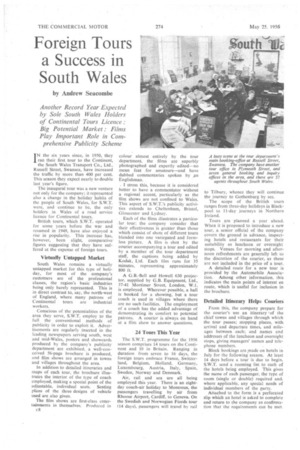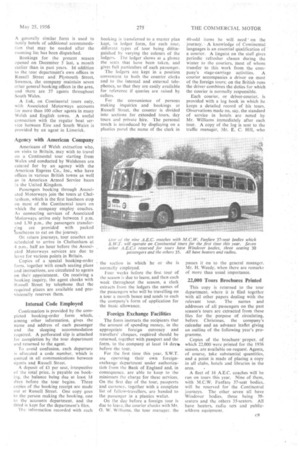Foreign Tours a Success in South Wales
Page 46

Page 47

If you've noticed an error in this article please click here to report it so we can fix it.
by Andrew Seacombe
Another Record Year Expected by Sole South Wales Holders of Continental Tours Licence : Big Potential Market : Films Play Important Role in Comprehensive Publicity Scheme
IN the six years since, in 1950, they ran their first tour to the Continent, the South Wales Transport Co., Ltd., Russell Street, Swansea, have increased the traffic by more than 400 per cent. This season they expect nearly to double last year's figure.
The inaugural tour was a new venture not only for the company; it represented also a change in the holiday habits of the people of South Wales, for S.W.T. were, and continue to be, the only holders in Wales of a road service licence for Continental tours.
British tours, which S.W.T. operated for some years before the war and resumed in 1949, have also enjoyed a rise in popularity. This increase has, however, been slight, comparative' .figures suggesting that they have suffered at the expense of foreign tours.
Virtually Untapped Market
South Wales remains a virtually untapped market for this type of holiday, for most of the company's customers are of the professional classes, the region's basic industries being only barely represented. This is in direct contrast to, say, the north-west of England, where many patrons of Continental tours are industrial workers.
Conscious of the potentialities of the area they serve, S.W.T. employ to the full the conventional methods of publicity in order to exploit it. Advertisements are regularly inserted in the leading newspapers serving south, west and mid-Wales, posters and showcards produced by the company's publicity department are exhibited, a well-conceived 56-page brochure is produced, and film shows are arranged in towns and villages throughout the area.
In addition to detailed itineraries and maps of each tour, the brochure illustrates the interior of the type of coach employed, making a special point of the adjustable, individual seats. Seating plans of the three designs of vehicle used are also given.
The film shows are first-class entertainments in themselves. Produced in c8 colour almost entirely by the tour department, the films are superbly photographed and expertly edited—no mean feat for amateurs—and have dubbed commentaries spoken by ,an Englishman.
. I stress this, because it is considered better to have a commentator without a regional accent, particularly as the film shows are not confined to Wales. This aspect of S.W.T.'s publicity activities extends to Cheltenham, Bristol, Gloucester and Lydney.
Each of the films illustrates a particular tour; the company consider that their effectiveness is greater than those which consist of shots of different tours blended into one variegated and formless picture. A film is shot by the courier accompanying a tour and edited by a member of the tour department staff, the captions being added by Kodak, Ltd. Each film runs for 35 minutes, representing approximately 800 ft.
A G.B.-Bell and Howell 630 projector, supplied by G.B. Equipment, Ltd., 37-41 Mortimer Street, London, W.1, is employed. Wherever possible, a hall is booked for a showing, but a tour coach is used in villages where there are no such facilities. The employment of a coach has the added advantage of demonstrating its comfort to potential patrons. A courier is always on hand at a film show to answer questions.
24 Tours This Year
The S.W.T. programme for the 1956 season comprises 14 tours on the Continent and 10 in Britain. Ranging in duration from seven to 16 days, the foreign tours embrace France, Switzerland, Belgium, Holland, Germany, Luxembourg, Austria, Italy, Spain, Sweden, Norway and Denmark.
Air, rail and sea are all being employed this year. There is an eightday coach-air holiday to Montreux, the passengers travelling by air from Rhoose Airport, Cardiff, to Geneva. On the Swedish and Norwegian Fiords tour (14 days), passengers will travel by rail
to Tilbury, whence they will continue the journey to Gothenburg by sea.
The scope of the British tours ranges from three-day holidays in Blackpool to 11-day journeys in Northern Ireland.
Tours are planned a year ahead. When it is proposed to introduce a new tour, a senior official of the company covers the ground in advance, inspecting hotels and restaurants for their suitability as luncheon or overnight stops. Venues for morning and afternoon refreshments are generally left to the discretion of the courier, as these are not included in the price of a tour.
A detailed route for a new tour is provided by the Automobile Association. Among other information, this indicates the main points of interest en route, which is useful for inclusion in the brochure.
Detailed Itinerary Helps. Couriers From this, the company prepare for the courier's use an itinerary (of the chief towns and villages through which the tour passes; stopping places, with arrival and departure times, and mileages between each; and names and addresses of the luncheon and overnight stops, giving managers' names and telephone numbers.
Block bookings are made on hotels in July for the following season. At least 14 days before a tour is due to begin, S.W.T. send a rooming list to each of the hotels being employed. This gives the name of each passenger, the type of room (single or double) required and, where applicable, any special needs of individual members of the party.
Attached to the form is a perforated slip which an hotel is asked to complete and return to the company as confirmation that the requirements can be met. A generally similar form is used to notify hotels of additional accommodation that may be needed after the rooming list has been dispatched.
Bookings for the present season opened on December 5 last, a month earlier than in past years. Irt addition to the tour department's own offices in Russell Street and Plymouth Street, Swansea, the company maintain seven other general booking offices in the area, ind there are 37 agents throughout South Wales.
A link, on Continental tours only, with Associated Motorways accounts for more than 100 other agents in many Welsh and English towns. ,A useful connection with the regular boat service between Eire and South Wales is provided by art agent in Limerick.
Agency with American Company
Americans of Welsh extraction who, on visits to Britain, may wish to travel on a Continental tour starting from Wales and conducted by Welshmen are catered for by an agency with the American Express Co., Inc., who have offices in various British towns as well as in American 'Armed Service bases in the United Kingdom.
Passengers booking through Associated Motorways join the tours at Cheltenham, which is the first luncheon stop on most of the Continental tours on which the company employ. coaches. As connecting services of Associated Moforways arrive only between 1 p.m. and 1.30 p.m., the passengers transfer ring are provided with packed•luacheons to eat on the journey.
On return journeys, tour coaches are scheduled to arrive in Cheltenham. at 4 p.m., half an hour before the Associated Motorways services are due to leave for various points in Britain.
Copies of a special booking-order form, together with coach seating plans and instructions, are circulated to agents on their appointment. On receiving a booking inquiry, the agent checks with ussell Street by telephone that the required places are available and provisionally reserves them.
Internal Code Employed
Confirmation is provided by the completed booking-order form which, among other information, gives the name and address of each passenger and the sleeping accommodation required. A perforated slip is attached for completion by the tour department and returned to the agent.
To avoid confusion, each departure is allocated a code number, which is quoted in all communications between agents and Russell Street, A deposit of £1 per seat, irrespective of the total price, is payable on booking, the balance being due at least, 14 days before the tour begins. Three copies of the booking receipt are made out at Russell Street. One copy goes to the person making the booking, one to the accounts department, and the third is kept for the department's files..
The information recorded with each booking is transferred to a master plan kept, in ledger form, for each tour, different types of tour being diStinguished by varying the colours of the ledgers. The ledger shows at a glance the seats that have been taken, and gives full particulars of each passenger.
The ledgers are kept in a position convenient to both the counter clerks and to the internal and external telephones, so that they are easily available for reference if queries are raised by callers.
For the convenience of persons making inquiries and bookings at Russell Street, the counter is divided into sections for extended tours, day tours and private hire. The personal touch is introduced by displaying on a plastics panel the name df the clerk in the section in which he or she is normally employed.
Four weeks before thefirst tout of the season is due to leave, and then each week throughout the season, a clerk extracts from the ledgers the names of the passengers who will be travelling on a tour a month hence and sends to each the company's form of application for the basic allowance.
Foreign Exchange Facilities _
The form instructs the recipients that the amount of spending money, in the appropriate foreign currency and travellers' cheques, required should be returned, together with passport and the form, to the company at least 14 day* before the tour.
For the first time this year, S.W.T. are operating their own foreignexchange department under authorizatiot from the Bank of England and, in consequence. are able to keep to the minimum the charge for these services. On the first day of the tour, passports and currency, together with a complete list of fellow-travellers, are handed to the passenger in a plastics wallet.
On the day before a .foreign tour is due to leave, the courier checks with Mr. O. W. Williams. the tour manager, the 40-odd items he will need • on the journey. A knowledge of Continental languages is an essential qualification of a courier. A linguist on the staff gives periodic refresher classes during the winter to the couriers, most of whom transfer to this work from the company's stage-carriage activities. A courier accompanies a driver on most of the foreign tours; on the British runs the driver combines the duties for which the courier is normally responsible.
Each courier, or driver-courier, is provided with a log book in which he keeps a detailed record of his tours. Observations made on, say, the standard of service in hotels are noted by Mr. Williams immediately after each tour. A copy of the log is sent to the traffic manager, Mr. E. C. Hill, who passes it on to the general manager, Mr. H. Weedy, when there are remarks of more than usual importance.
22,000 Tours Brochures Printed
This copy is returned to the tour department, where it is filed together with all other papers dealing with the relevant tour. The names and addresses of all passengers on the past season's tours are extracted from these files for the purpose of circulating, before Christmas, the company's calendar and an advance leaflet giving an outline of the following year's programme.
Copies of the brochure proper, of which 22,000 were printed for the 1956 season, are available on request. Agents, of course, take substantial quantities, and a point is made of placing a copy in all clubs, hotels and libraries in the area.
A fleet of 16 A.E.C. coaches will be run on tours this year. Nine of them, with M.C.W. Fanfare 37-seat bodies, will be reserved for the Continental journeys. The other seven all have Windover bodies, three being 30seaters and the others 35-seaters. All have heaters, radio sets and publicaddress equipment.














































































































